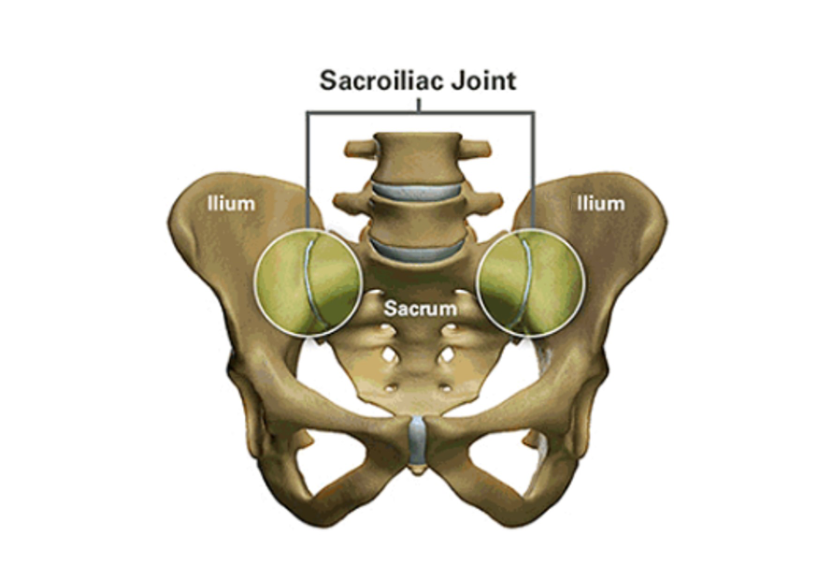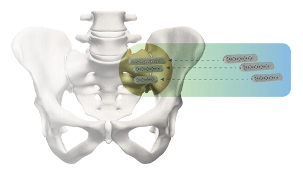The SI joint, or sacroiliac joint, can be a significant cause of lower back pain that affects other areas. Clinical publications have identified the SI joint as a pain generator in 15-30% of chronic lower back pain patients.1-4 In addition, the SI joint is a pain generator in up to 43% of patients with continued or new onset lower back pain after a lumbar fusion.5
Debilitating SI joint pain may not have to be permanent, though. While other treatment options may only provide short-term results, at Pinehurst Surgical Clinic, our Orthopaedics Surgery department offers minimally invasive SI Joint surgery for life-changing results.
The SI joint is located in the pelvis and links its iliac bones to the sacrum (the lowest part of the spine above the tailbone). It is an essential component for energy transfer between the legs and the torso, and the load it has to bear can lead to abnormal, painful motion.
Like any other joint in the body, the SI joint can be injured and/or undergo degeneration. This is especially true while lifting, running, walking, or even lying on the involved side.

It’s common for pain from the SI joint to feel like disc or lower back pain, or sometimes hip or groin pain. For this reason, SI joint disorders should always be considered in lower back, hip and pelvic pain diagnosis. Symptoms can include:



A variety of tests performed during physical examination may help reveal the SI joint as the cause of your symptoms. Sometimes, X-rays, a CT-scan, or MRI may be helpful in the diagnosis of SI joint-related problems. This is because they can rule out other common sources of pain—such as your lumbar spine or hip joints. It is also important to remember that other conditions (like a disc problem) can co-exist with SI joint disorders.
The most relied upon method to accurately determine whether the SI joint is the cause of your lower back pain symptoms is to inject the SI joint with a local anesthetic. This diagnostic injection will be performed under either X-ray or CT guidance to verify accurate placement of the needle in the SI joint. If your symptoms decrease by at least 50%, it can be concluded that the SI joint is either the source of or a major contributor to your lower back, hip, or pelvic pain. If the level of pain does not change after SI joint injection, it is less likely that the SI joint is the cause of your pain.
Once the SI joint is confirmed as the cause of your symptoms, treatment can begin. Some patients respond well to physical therapy, use of oral medications, or injection therapy. These treatments are often performed repetitively, and often, symptom improvement using these therapies is temporary. If non-surgical treatment options have been tried and do not provide long-term relief, your surgeon may consider other options, including the minimally invasive iFuse procedure.
The iFuse Implant System is designed to stabilize and fuse the SI joint. The iFuse procedure involves inserting typically three triangular-shaped titanium implants across the sacroiliac joint to maximize SI joint stability, reduce pain, and improve function. The procedure is done through a small one-inch incision and takes about an hour. SI joint treatment using the patented triangular design of the iFuse implant has been clinically evaluated more than any other SI joint fusion procedure.*
More than 100 peer-reviewed publications demonstrate the safety, durable effectiveness, and biomechanical and economic benefits of the iFuse implant (www.si-bone.com/results). However, as with any minimally invasive surgical procedures, there are potential risks associated with the iFuse Implant System. For information about the risks, visit www.si-bone.com/risks.

Your first step is making an appointment with one of our two iFuse-trained surgeons to discuss your options. For more information and to make an appointment, please call our Orthopaedic Surgery department at (910) 295-0295 or schedule online with Alexander C. Lemons, MD, or Daniel M. Williams, MD, at our Pinehurst/Moore County location.
Book NowReferences
1. Polly DW, et al., and the INSITE Study Group. Two-Year Outcomes from a Randomized Controlled Trial of Minimally Invasive Sacroiliac Joint Fusion vs. Non-Surgical Management for Sacroiliac Joint Dysfunction. Int J Spine Surg. 2016;10:Article 28. DOI: 10.14444/3028
2. Dengler J, et al. Randomized Trial of Sacroiliac Joint Fusion vs. Conservative Management for Chronic Low Back Pain Attributed to the Sacroiliac Joint. J Bone Joint Surg Am. 2019;101(5):400-11. DOI: 10.2106/JBJS.18.00022.
3. Duhon B, Bitan F, Lockstadt H, Kovalsky D, Cher D, Hillen T, on behalf of the SIFI Study Group. Triangular Titanium Implants for Minimally Invasive Sacroiliac Joint Fusion: 2-Year Follow-Up from a Prospective Multicenter Trial. Int J Spine Surg. 2016;10:Article 13. DOI: 10.14444/3013
4. Dengler J, et al. on behalf of the INSITE, iMIA and SIFI study groups. Predictors of Outcome in Conservative and Minimally Invasive Surgical Management of Pain Originating from the Sacroiliac Joint - a Pooled Analysis. Spine. 2017;42(21):1664-73. [Epub 2017 Mar 27]. DOI: 10.1097/BRS.0000000000002169
5. DePalma MJ, et al. Etiology of Chronic Low Back Pain Patients Having Undergone Lumbar Fusion. Pain Med. 2011;12:732-9.
*The iFuse Implant System® is intended for sacroiliac fusion for conditions including sacroiliac joint dysfunction that is a direct result of sacroiliac joint disruption and degenerative sacroiliitis. This includes conditions whose symptoms began during pregnancy or in the peripartum period and have persisted postpartum for more than 6 months. It is also intended for sacroiliac fusion to augment immobilization and stabilization of the sacroiliac joint in skeletally mature patients undergoing sacropelvic fixation as part of a lumbar or thoracolumbar fusion or for acute, non-acute, and non-traumatic fractures involving the sacroiliac joint. There are potential risks associated with the iFuse Implant System. It may not be appropriate for all patients and all patients may not benefit. For information about the risks, visit www.si-bone.com/risks.